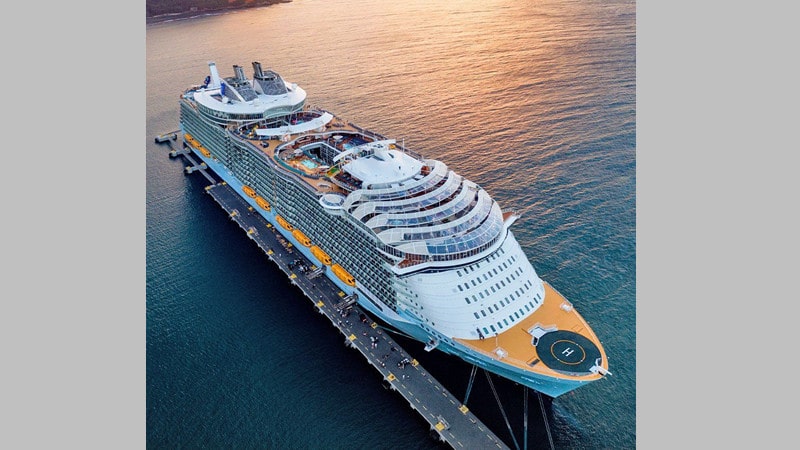From cruise liners to oil tankers, some of the largest ships that have ever been built are sheer marvels of engineering and technology. These mega machines used for diverse purposes like transporting people, transferring goods, and used in war also require unique engineering systems like massive diesel engines and nuclear propulsion systems.
This article lists 10 of the biggest ships in the world (including the legendary Titanic!), exploring the complex manufacturing and design processes that power these massive machines.
#1. Titanic

Image source: Pinterest
When you think of big ships, you probably think of Titanic — the classic film with the best of Hollywood stars and the worst of tragic endings. Built in the early 1900s, this massive passenger liner had an overall registered length of 882 feet and 9 inches, weighing 46,328 gross register tons.
Paired with a passenger capacity of 2,453 passengers and a crew capacity of 892, the Titanic could displace a staggering 52, 310 tons.
The ship contained 840 staterooms, 20 lifeboats, 4 restaurants, and a variety of amenities such as heated pools, gyms, first-class dining saloons, billiards room, and men’s brandy rooms.
While the Titanic was often referred to as the best luxury passenger ship ever built, it did not enjoy a long stay in the limelight. It sank on its maiden voyage shortly after colliding with an iceberg, killing over 500 passengers and crew members — making it one of the worst maritime tragedies ever recorded.
Is There Any Ship Bigger Than Titanic?
At the time of its maiden voyage in 1912, the Titanic was rightly referred to as the largest ship afloat.
Today, however, there are several ships that have surpassed the Titanic’s commanding size. Some of them are listed below.
#2. Harmony of the Seas

Image source: Pinterest
The Harmony of the Seas is a passenger ship that measures 36,212 meters in length, 66 meters in width, and has a gross tonnage of 226,963 GT. This Royal Caribbean ship is the second-largest cruise ship in the world, surpassing two of her sister ships — Allure of the Seas and Oasis of the Seas, the second and third largest cruise ships, respectively, in the “Oasis-class” series.
The Harmony of the Seas is a behemoth with 2,747 cabins complete with virtual balconies, 23 swimming pools, 20 dining halls, as well as a 1400-seat theater. It can accommodate 5,479 guests at double occupancy.
On its inaugural journey in June 2017, it took passengers on a 7-night Western Mediterranean cruise between Barcelona and Civitavecchia. Just like its sister ships, the Harmony of the Seas also has exclusive features such as robot bartenders in its Bionic bar, a Central Park, the first at-sea production of “Grease,” as well as a fitness center.
#3. Mardi Gras

Image source: Pinterest
The new Mardi Gras is named after the cruise line’s first ship, the TSS Mardi Gras, which sailed for Carnival from 1972 to 1993. The new Mardi Gras measures 1,130 feet in length, weighs 180,000 GT, and has a 5,280 passenger capacity on double occupancy.
The first U.S ship to run on eco-friendly liquified natural gas, Mardi Gras now ranks in the top 10 largest ships in the world.
The ship, built by Meyer Turku Shipyard amid the pandemic, was delivered in December 2020 to be operated by the world’s largest cruise ship operator — Carnival Cruise Lines. It has a cutting-edge pandemic proofing plan in place to ensure the best possible passenger care and experience.
#4. Iona

Image source: Pinterest
P&O Cruises’ LNG-fueled cruise ship Iona is the largest UK-based cruise line ship to date. Although the ship was scheduled to begin operations in May 2020, its delivery was delayed due to the COVID-19 pandemic. It wasn’t delivered until October 2020, after which it began its operations successfully.
Iona is 345 meters long, with a gross tonnage of 185,000 GT. It hosts 17 passenger decks and can accommodate 5,200 passengers and 1,800 crew members.
The cruise liner also features 30 restaurants with incredibly flexible dining options, as well as 95 conservatory mini-suites that are a cross between a balcony cabin and a suite. Featuring spectacular facilities, Iona promises a high-end hospitality experience.
#5. Kirov-Class Cruiser

Image source: Pinterest
The Kirov-Class is a collection of six nuclear-powered guided missile cruisers built for the Soviet Navy. Of these, the Kirov, the class’ lead ship, was renamed Admiral Ushakov in 1992. Commissioned in 1980, the Kirov made her first appearance in 1981.
The ship measured 252 meters in length, with a 28.5-meter beam and a displacement of 24,300 tonnes (standard). The ship is armed to the teeth, with 20 P-700 missiles mounted on its deck along with eight 30 mm (1.18 in) AK-630 close-in weapon systems and SS-N-14 anti-submarine warfare missiles.
The ship, while being an absolute monster of a cruiser, has been pretty expensive to maintain. As a result, in 1990, when Kirov suffered problems with one of its two reactors, it was never repaired due to the financial instability caused by the fall of the Soviet Union and is now in reserve.
That said, Russia appears to have plans for the ships that are left that may involve advanced ammunition and defenses, maybe even lasers! Who knows?
#6. America-Class Amphibious Assault Ship

Image source: Pinterest
America-Class Amphibious Assault Ships are the largest vessels (of their class) ever built. Their design is based on USS Makin Island — the last ship of the Wasp-class — with a few modifications like more deck space and larger hangar facilities added for more space for aviation purposes.
Its lead ship, the USS America, was commissioned into the US Navy in 2014 to replace the USS Peleliu of the “Tarawa class.”
The America Class ships are 257 meters long, have a beam of 32 meters, and a displacement of 45,000 long tonnes. They carry 1700 marines and their equipment. These ships are also equipped with a CODLOG Hybrid electric propulsion system that can switch between gas turbines for high speed and diesel-electric engines, depending on the situation.
The first two ships of this class have been optimized for aviation, allowing marines to reach their objectives more quickly.
#7. Clemenceau-Class Aircraft Carrier

Image source: Pinterest
The Clemenceau-Class Aircraft Carrier is France’s first successful aircraft design after World War II. It served in the French Navy from 1961 until 1997. It measured 265 meters in length, had a beam of 51.2 meters, and displaced just under 35,000 tonnes. It was the second French warship to be named after Georges Clemenceau.
The Clemenceau carriers feature a conventional CATOBAR design. They were small and effective but posed some stability and armament holding capacity issues and were thus re-fitted and updated a few times.
After sailing over 1,000,000 nautical miles and spending 3,125 days at sea, Clemenceau — also affectionately called “le clem” — was demolished in 2009-2010. Her sister ship, the Foch, is still up and running.
#8. Symphony of the Seas

Image source: Pinterest
When it was built in 2017-2018, the Symphony of the Seas, an Oasis-class cruise ship, was the world’s largest cruise ship (based on gross tonnage). This Royal Caribbean International ship measures 361.011 meters in length and has a gross tonnage of 228,081 GT spread across 18 decks.
It has 16 passenger decks, a passenger capacity of 5,518 at double occupancy, and can accommodate a crew of 2,200 people.
Passengers have affectionately dubbed this cruise ship “the best family holiday destination” because it offers a bold lineup of events and experiences. Some of the activities and experiences it offers are glow-in-the-dark laser games, fine-dining restaurants, ice skating, AquaTheatre shows, interactive arts, and the 10-story tall slide called the Ultimate Abyss.
#9. HMM Algeciras – Largest Containment Ship

Image source: Pinterest
HMM (Hyundai Merchant Marine) Algeciras — a Panama-registered ship built by Daewoo Shipbuilding and Marine Engineering — is the world’s largest containership that surpasses the previous Gulsun class in terms of container capacity. The ship was completed at Daewoo Shipping and Marine Engineering’s Okpo Shipyard on 24th April 2020.
It is one of twelve 24000 TEU Class eco-friendly ships developed with the aim to reduce HMM’s environmental footprint. The HMM Algeciras is also a “Megamax-24” container vessel that can hold 24 containers (12 below deck and 12 above).
The ship is 399.9 meters long, 33.2 meters wide, and has a gross tonnage of 228,283 GT. On its maiden voyage to Rotterdam’s Amaliahaven, it carried a massive total of 19, 621 TEU on board.
It is believed that the HMM will serve as a bridge for South Korea to secure a mutually beneficial partnership with Europe.
#10. Knock Nevis

Image source: Pinterest
Knock Nevis — also known as Seawise Giant, Happy Giant, Mont, Jahre Viking — is the longest self-propelled ship ever built. This ULCC supertanker, built in 1974-1979 by Sumitomo Heavy Industries Ltd in Japan, has a length of 458.45 meters, a beam measuring 68.6 meters, and a colossal displacement of 260, 941 GT when fully laden.
This ship is so large that it could fit four soccer fields laid end-to-end on her deck alone!
In 1988, this supertanker was damaged in a missile attack during the Iran-Iraq war and sank in the Strait of Hormuz. Once the war ended, Norman International salvaged the ship, repaired it in Singapore, and renamed it “Happy Giant” before returning it to active duty.
Knock Nevis served until 2009, following which it was sold to Indian shipbreakers for demolition. It was renamed “Mont” for her final voyage in December 2009.







